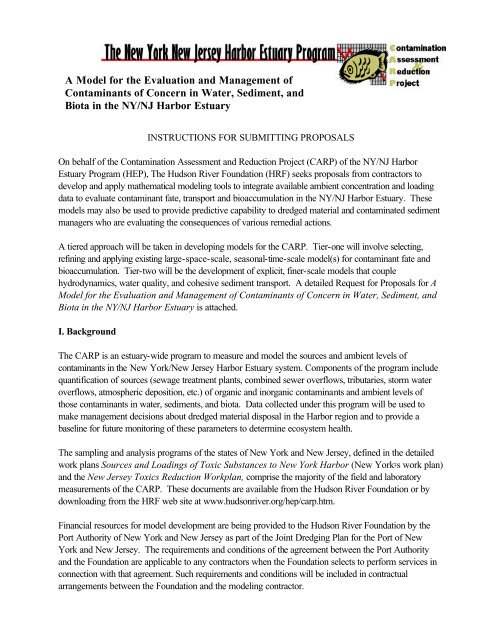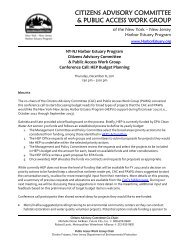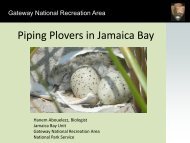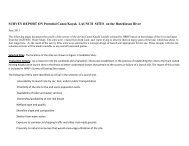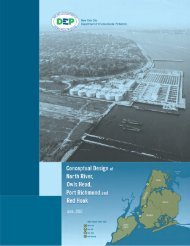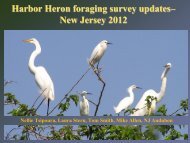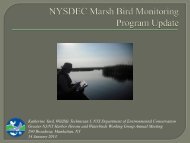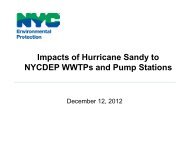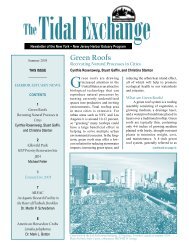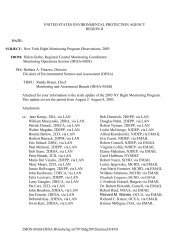A Model for the Evaluation and Management of Contaminants of ...
A Model for the Evaluation and Management of Contaminants of ...
A Model for the Evaluation and Management of Contaminants of ...
Create successful ePaper yourself
Turn your PDF publications into a flip-book with our unique Google optimized e-Paper software.
A <strong>Model</strong> <strong>for</strong> <strong>the</strong> <strong>Evaluation</strong> <strong>and</strong> <strong>Management</strong> <strong>of</strong><br />
<strong>Contaminants</strong> <strong>of</strong> Concern in Water, Sediment, <strong>and</strong><br />
Biota in <strong>the</strong> NY/NJ Harbor Estuary<br />
INSTRUCTIONS FOR SUBMITTING PROPOSALS<br />
On behalf <strong>of</strong> <strong>the</strong> Contamination Assessment <strong>and</strong> Reduction Project (CARP) <strong>of</strong> <strong>the</strong> NY/NJ Harbor<br />
Estuary Program (HEP), The Hudson River Foundation (HRF) seeks proposals from contractors to<br />
develop <strong>and</strong> apply ma<strong>the</strong>matical modeling tools to integrate available ambient concentration <strong>and</strong> loading<br />
data to evaluate contaminant fate, transport <strong>and</strong> bioaccumulation in <strong>the</strong> NY/NJ Harbor Estuary. These<br />
models may also be used to provide predictive capability to dredged material <strong>and</strong> contaminated sediment<br />
managers who are evaluating <strong>the</strong> consequences <strong>of</strong> various remedial actions.<br />
A tiered approach will be taken in developing models <strong>for</strong> <strong>the</strong> CARP. Tier-one will involve selecting,<br />
refining <strong>and</strong> applying existing large-space-scale, seasonal-time-scale model(s) <strong>for</strong> contaminant fate <strong>and</strong><br />
bioaccumulation. Tier-two will be <strong>the</strong> development <strong>of</strong> explicit, finer-scale models that couple<br />
hydrodynamics, water quality, <strong>and</strong> cohesive sediment transport. A detailed Request <strong>for</strong> Proposals <strong>for</strong> A<br />
<strong>Model</strong> <strong>for</strong> <strong>the</strong> <strong>Evaluation</strong> <strong>and</strong> <strong>Management</strong> <strong>of</strong> <strong>Contaminants</strong> <strong>of</strong> Concern in Water, Sediment, <strong>and</strong><br />
Biota in <strong>the</strong> NY/NJ Harbor Estuary is attached.<br />
I. Background<br />
The CARP is an estuary-wide program to measure <strong>and</strong> model <strong>the</strong> sources <strong>and</strong> ambient levels <strong>of</strong><br />
contaminants in <strong>the</strong> New York/New Jersey Harbor Estuary system. Components <strong>of</strong> <strong>the</strong> program include<br />
quantification <strong>of</strong> sources (sewage treatment plants, combined sewer overflows, tributaries, storm water<br />
overflows, atmospheric deposition, etc.) <strong>of</strong> organic <strong>and</strong> inorganic contaminants <strong>and</strong> ambient levels <strong>of</strong><br />
those contaminants in water, sediments, <strong>and</strong> biota. Data collected under this program will be used to<br />
make management decisions about dredged material disposal in <strong>the</strong> Harbor region <strong>and</strong> to provide a<br />
baseline <strong>for</strong> future monitoring <strong>of</strong> <strong>the</strong>se parameters to determine ecosystem health.<br />
The sampling <strong>and</strong> analysis programs <strong>of</strong> <strong>the</strong> states <strong>of</strong> New York <strong>and</strong> New Jersey, defined in <strong>the</strong> detailed<br />
work plans Sources <strong>and</strong> Loadings <strong>of</strong> Toxic Substances to New York Harbor (New York=s work plan)<br />
<strong>and</strong> <strong>the</strong> New Jersey Toxics Reduction Workplan, comprise <strong>the</strong> majority <strong>of</strong> <strong>the</strong> field <strong>and</strong> laboratory<br />
measurements <strong>of</strong> <strong>the</strong> CARP. These documents are available from <strong>the</strong> Hudson River Foundation or by<br />
downloading from <strong>the</strong> HRF web site at www.hudsonriver.org/hep/carp.htm.<br />
Financial resources <strong>for</strong> model development are being provided to <strong>the</strong> Hudson River Foundation by <strong>the</strong><br />
Port Authority <strong>of</strong> New York <strong>and</strong> New Jersey as part <strong>of</strong> <strong>the</strong> Joint Dredging Plan <strong>for</strong> <strong>the</strong> Port <strong>of</strong> New<br />
York <strong>and</strong> New Jersey. The requirements <strong>and</strong> conditions <strong>of</strong> <strong>the</strong> agreement between <strong>the</strong> Port Authority<br />
<strong>and</strong> <strong>the</strong> Foundation are applicable to any contractors when <strong>the</strong> Foundation selects to per<strong>for</strong>m services in<br />
connection with that agreement. Such requirements <strong>and</strong> conditions will be included in contractual<br />
arrangements between <strong>the</strong> Foundation <strong>and</strong> <strong>the</strong> modeling contractor.
II. Criteria <strong>for</strong> Evaluating Proposals<br />
Proposals will be evaluated using <strong>the</strong> following criteria:<br />
$ Demonstrated experience in conducting similar work successfully<br />
$ Qualifications <strong>of</strong> <strong>the</strong> personnel to be assigned to <strong>the</strong> program<br />
$ Merit <strong>of</strong> proposed approach to accomplishing objectives outlined in <strong>the</strong> RFP<br />
$ Likelihood <strong>of</strong> success in meeting stated objectives<br />
$ Cost<br />
III. Proposal Submittal In<strong>for</strong>mation<br />
Proposals should be no longer than 20 pages <strong>and</strong> include <strong>the</strong> following elements:<br />
$ Cover Page (please use attached <strong>for</strong>m)<br />
$ Statement <strong>of</strong> Work: Proposers should present a clear <strong>and</strong> detailed description <strong>of</strong> <strong>the</strong> modeling<br />
approach <strong>the</strong>y intend to follow. The discussion shall include reasons <strong>for</strong> acceptance or rejection<br />
<strong>of</strong> elements <strong>of</strong> <strong>the</strong> modeling approach outlined in <strong>the</strong> attached RFP. Where modifications are<br />
<strong>of</strong>fered, justification should be given. Proposers should relate relevant experiences to <strong>the</strong> project<br />
<strong>the</strong>y are now proposing. The Statement <strong>of</strong> Work should generally be no longer than 20 pages.<br />
$ Qualifications <strong>and</strong> CV(s) <strong>of</strong> all project personnel<br />
$ Statement <strong>of</strong> related experience <strong>of</strong> <strong>the</strong> contractor<br />
$ Itemized budget: (Please use <strong>the</strong> <strong>for</strong>ms provided.) The project budget is to be shown in two<br />
ways: (1) Total project budget by category <strong>of</strong> expense on <strong>the</strong> attached Hudson River<br />
Foundation <strong>for</strong>m, <strong>and</strong> (2) Total project budget by task. Tasks <strong>for</strong> this contract are described in<br />
bulleted lists in sections VII <strong>and</strong> VIII on pages 11-17 <strong>of</strong> <strong>the</strong> attached Request <strong>for</strong> Proposals. For<br />
each task, proposals should provide a detailed cost breakdown.<br />
Project period: Four years<br />
Approximate level <strong>of</strong> funding <strong>for</strong> entire modeling project: $2,500,000.00<br />
Deadline:<br />
Proposals (original plus 20 copies) must be received by <strong>the</strong> <strong>of</strong>fice listed below by <strong>the</strong><br />
close <strong>of</strong> business on Friday, September 8, 2000.<br />
Contacts: Submit proposals to: Dr. Dennis Suszkowski<br />
Hudson River Foundation<br />
40 West 20 th Street,9 th Floor<br />
New York, NY 10011<br />
For more in<strong>for</strong>mation contact Dr. Suszkowski at (212) 924-8290 or dennis@hudsonriver.org.
NY/NJ Harbor Estuary Program<br />
Contamination Assessment <strong>and</strong> Reduction Project<br />
<strong>Model</strong>ing<br />
Proposal Cover Page<br />
Hudson River Foundation<br />
Proposal #:<br />
For HRF use<br />
Name <strong>of</strong> Firm/Contractor:<br />
Summary <strong>of</strong> Proposal:<br />
Amount Requested:<br />
Total:<br />
$________________<br />
Year-1:<br />
Year-2:<br />
Year-3:<br />
Year-4:<br />
$________________<br />
$________________<br />
$________________<br />
$________________<br />
Principal Investigator(s):<br />
(Name, Title, Address, Phone, Fax, e-mail)<br />
Contract Administrator:<br />
(Name, Title, Address, Phone)<br />
Proposal Approval:<br />
Payments to be sent to:<br />
(Name, Title, Address, Phone)<br />
Applicant's Tax Status<br />
❑<br />
❑<br />
❑<br />
❑<br />
❑<br />
Tax Exempt under 501(c)3<br />
Not a Private Foundation<br />
under Sec. 509(a)<br />
Private Foundation<br />
Not Tax-Exempt<br />
Government<br />
_________________________ __________<br />
Institutional Representative Signature Date<br />
(Include typed name & title below if different from Contract Administrator)<br />
_________________________<br />
Principal Investigator Signature<br />
__________<br />
Date
PROPOSAL BUDGET SUMMARY<br />
Hudson River Foundation/CARP <strong>Model</strong>ing<br />
FOR HRF USE<br />
Grant #<br />
Principal Investigator<br />
Proposal #<br />
Organization<br />
$<br />
REQUESTED<br />
FROM HRF<br />
$<br />
COST SHARING<br />
$<br />
TOTAL COST<br />
DIRECT COSTS<br />
Labor (list personnel by name, support personnel by category)<br />
1)<br />
2)<br />
3)<br />
4)<br />
5)<br />
6)<br />
A. Total Labor Costs<br />
B. Fringe Benefits<br />
Non-Expendable Equipment (list item <strong>and</strong> amount <strong>for</strong> each item exceeding $500)<br />
C. Total Non-Expendable Equipment<br />
D. Expendable equipment<br />
E. Equipment Rental<br />
F. Boat Use<br />
G. Computer Services<br />
H. Consultant Services (o<strong>the</strong>r than subcontracts)<br />
I. Travel<br />
J. Publication Costs<br />
Office Support (only when directly relevant to per<strong>for</strong>mance <strong>of</strong> <strong>the</strong> proposed project)<br />
Materials <strong>and</strong> Supplies<br />
Telephone<br />
Postage<br />
Copying <strong>and</strong> Printing<br />
K. Total Ofice Support<br />
L. Miscellaneous (specify)<br />
M. TOTAL DIRECT COSTS (A through L)<br />
N. INDIRECT COSTS/OVERHEAD (specify)<br />
O. SUBCONTRACTS (attach separate budgets)<br />
P. TOTAL COSTS (M + N + O)
Budget Breakdown by Task<br />
CARP <strong>Model</strong>ing Proposal<br />
Hudson River Foundation<br />
FOR HRF USE<br />
Proposal #<br />
Please note: Please provide detailed descriptions <strong>of</strong> <strong>the</strong> budget<br />
<strong>for</strong> each task, including amount <strong>of</strong> time each task will require,<br />
on an attached sheet(s).<br />
Principal Investigator<br />
Organization<br />
$<br />
TOTAL COST<br />
TASK (see RFP <strong>for</strong> fur<strong>the</strong>r details)<br />
1-1: Select a large-space-scale, seasonal-time-scale model<br />
1-2: Refine <strong>the</strong> selected model(s) to ensure inclusion <strong>of</strong> additonal features<br />
1-3: Review <strong>and</strong> compile recent baseline data <strong>for</strong> <strong>the</strong> Harbor<br />
1-4: Compile new/updated loading estimates <strong>for</strong> contaminants<br />
1-5: Conduct calibrations/verifications using availalble CARP monitoring data<br />
1-6: Conduct model sensitivity runs<br />
1-7: Conduct model scenario analyses<br />
1-8: Develop user interface <strong>for</strong> simulating additional scenarios<br />
1-9: Develop modeling approach <strong>for</strong> evaluating sediment toxicity<br />
TOTAL, TASKS 1-1 - 1-9<br />
2-1: Develop Tier-2 model(s)<br />
2-2: Review NY <strong>and</strong> NJ sampling designs <strong>and</strong> recommend modifications<br />
TOTAL, TASKS 2-1 - 2-2<br />
3-1: Develop user manuals <strong>for</strong> applying Tier 1 <strong>and</strong> Tier 2 models<br />
3-2: Provide training to CARP participants on <strong>the</strong> use <strong>of</strong> models<br />
3-3: Provide recommendation <strong>and</strong> cost estimate <strong>for</strong> long-term model maintenance<br />
TOTAL, TASKS 3-1 - 3-3<br />
GRAND TOTAL, ALL TASKS
A <strong>Model</strong> <strong>for</strong> <strong>the</strong> <strong>Evaluation</strong> <strong>and</strong><br />
<strong>Management</strong> <strong>of</strong> <strong>Contaminants</strong> <strong>of</strong><br />
Concern<br />
in Water, Sediment, <strong>and</strong> Biota<br />
in <strong>the</strong><br />
NY/NJ Harbor Estuary<br />
Request For Proposals<br />
July 21, 2000<br />
Hudson River Foundation<br />
40 West 20 th Street, 9 th floor<br />
New York, NY 10011
I. Introduction<br />
A consortium <strong>of</strong> state, federal <strong>and</strong> non-pr<strong>of</strong>it agencies is collaborating on a project to<br />
establish a scientifically sound basis <strong>for</strong> mitigating chemical contamination in <strong>the</strong> New<br />
York/New Jersey Harbor Estuary. This project – <strong>the</strong> Contamination Assessment <strong>and</strong><br />
Reduction Project (CARP) – is an outgrowth <strong>of</strong> <strong>the</strong> <strong>for</strong>mer Sediment Contaminant<br />
Reduction Work Group (SCRWG) <strong>of</strong> <strong>the</strong> New York/New Jersey Harbor Estuary Program<br />
(HEP). The principal tasks to be undertaken by CARP are those that have been<br />
recommended in <strong>the</strong> final Comprehensive Conservation <strong>and</strong> <strong>Management</strong> Plan (CCMP)<br />
<strong>for</strong> <strong>the</strong> HEP. These tasks include investigations <strong>of</strong> <strong>the</strong> interactions <strong>of</strong> contaminants with<br />
water, sediment <strong>and</strong> biota, <strong>and</strong> <strong>the</strong> response <strong>of</strong> such interactions to changing contaminant<br />
inputs throughout <strong>the</strong> Estuary.<br />
The contamination <strong>of</strong> <strong>the</strong> estuary is resulting in economic hardships (e.g., dredging delays<br />
<strong>and</strong> more expensive disposal options), public health concerns (e.g., dredged material<br />
h<strong>and</strong>ling <strong>and</strong> disposal, <strong>and</strong> fish consumption advisories), <strong>and</strong> ecological concerns (e.g.,<br />
contaminant-related acute <strong>and</strong> chronic effects on aquatic life).<br />
Recently, CARP began work on a bi-state ef<strong>for</strong>t to assess ambient concentrations <strong>of</strong><br />
hydrophobic organic contaminants <strong>and</strong> heavy metals in <strong>the</strong> NY/NJ Harbor Estuary, <strong>and</strong> to<br />
quantify contaminant loads to <strong>the</strong> Estuary. The data collection ef<strong>for</strong>ts are primarily being<br />
carried out under <strong>the</strong> supervision <strong>of</strong> <strong>the</strong> New York State Department <strong>of</strong> Environmental<br />
Conservation (NYSDEC) <strong>and</strong> <strong>the</strong> New Jersey Department <strong>of</strong> Environmental Protection<br />
(NJDEP). The CARP will provide <strong>the</strong> technical basis, through comprehensive data<br />
collection <strong>and</strong> modeling, <strong>for</strong> an estuary-wide contaminant reduction strategy.<br />
Overall, <strong>the</strong> CARP serves as a mechanism <strong>for</strong> articulating <strong>the</strong> Harbor contamination reduction<br />
goals contained in <strong>the</strong> HEP CCMP <strong>and</strong> supports <strong>the</strong> following objectives:<br />
• Development <strong>of</strong> a long-term Harbor monitoring <strong>and</strong> management system that tracks<br />
progress <strong>of</strong> contamination reduction plans;<br />
• Reduction <strong>of</strong> levels <strong>of</strong> <strong>the</strong> contaminants <strong>of</strong> concern such that water quality st<strong>and</strong>ards<br />
are met, dredged sediments meet all requirements <strong>for</strong> upl<strong>and</strong> beneficial use or <strong>for</strong><br />
remediation at <strong>the</strong> Historic Area Remediation Site (HARS), <strong>and</strong> fish/shellfish are<br />
safe <strong>for</strong> human consumption;<br />
• Identification <strong>and</strong> trackdown <strong>of</strong> significant sources <strong>of</strong> <strong>the</strong> contaminants <strong>of</strong> concern to<br />
water, sediment <strong>and</strong> biota, including existing sediment “hot spots;”<br />
• Development <strong>of</strong> management tools to assess, under different management<br />
scenarios, when appropriate water quality criteria <strong>and</strong> st<strong>and</strong>ards <strong>for</strong> <strong>the</strong> parameters<br />
<strong>of</strong> concern will be met in <strong>the</strong> water column;<br />
• Development <strong>of</strong> management tools to assess, under different management<br />
scenarios, <strong>the</strong> time frame required <strong>for</strong> Harbor sediments to support a healthy<br />
benthic community system <strong>and</strong> meet all state <strong>and</strong> federal requirements <strong>for</strong> upl<strong>and</strong><br />
beneficial use or use at <strong>the</strong> HARS.<br />
• Development <strong>of</strong> management tools <strong>for</strong> determining Total Maximum Daily Loads<br />
2
(TMDLs), as required by agreements between <strong>the</strong> U.S. Environmental Protection<br />
Agency (EPA) <strong>and</strong> <strong>the</strong> states <strong>of</strong> New York <strong>and</strong> New Jersey <strong>for</strong> substances <strong>of</strong><br />
concern, in all water, sediment <strong>and</strong>/or biota <strong>of</strong> <strong>the</strong> NY/NJ Harbor.<br />
• Development <strong>of</strong> management tools to predict concentrations <strong>of</strong> o<strong>the</strong>r substances<br />
determined by <strong>the</strong> Toxics Workgroup <strong>of</strong> HEP to be <strong>of</strong> concern in water, sediment,<br />
<strong>and</strong> biota;<br />
• Development <strong>of</strong> a management tool to predict effects <strong>of</strong> changes in Harbor<br />
bathymetry on <strong>the</strong> distribution <strong>of</strong> <strong>the</strong> contaminants <strong>of</strong> concern; <strong>and</strong><br />
• Development <strong>of</strong> a management tool to facilitate potential Natural Resource<br />
Damage Claims.<br />
It is <strong>the</strong> consensus <strong>of</strong> CARP participants that ma<strong>the</strong>matical modeling tools are needed to<br />
help <strong>the</strong> region address some or all <strong>of</strong> <strong>the</strong>se goals. Such models provide a means <strong>for</strong><br />
integrating available ambient concentration <strong>and</strong> loading data in a mass balance framework<br />
so that dominant fate <strong>and</strong> transport processes can be identified. Moreover, <strong>the</strong>se models<br />
may provide <strong>the</strong> predictive capability that managers <strong>and</strong> scientists need to assess <strong>the</strong><br />
consequences <strong>of</strong> various remedial actions (e.g., additional source trackdown ef<strong>for</strong>ts,<br />
remediation <strong>of</strong> contaminated sediments, TMDLs/WLAs/LAs, clean-up <strong>of</strong> contaminated<br />
sites) <strong>and</strong> to predict <strong>the</strong> time frames required <strong>for</strong> reductions in contaminant levels in Harbor<br />
waters, sediments <strong>and</strong> biota. Accordingly, this RFP provides generalized tasks <strong>and</strong><br />
specifications <strong>for</strong> <strong>the</strong> development <strong>and</strong> application <strong>of</strong> such models.<br />
II.<br />
<strong>Model</strong>ing Questions<br />
The specific questions that need to be addressed through modeling are as follows:<br />
What is <strong>the</strong> relative importance <strong>of</strong> specific loadings <strong>of</strong> contaminants to <strong>the</strong> quality<br />
<strong>of</strong> dredged material today? (What current pollutant sources/ loadings can be linked to<br />
contamination problems (i.e., criteria violations) at dredging locations in New York Harbor<br />
<strong>and</strong> what proportion <strong>of</strong> <strong>the</strong> problem is attributed to each source?)<br />
How will <strong>the</strong> quality <strong>of</strong> newly deposited sediments at future dredging sites change if no<br />
contaminant reduction actions are taken? How will <strong>the</strong> sediments be affected if specific<br />
contaminated loadings are reduced or eliminated?<br />
A. How long will it take <strong>for</strong> improvement in newly deposited sediment quality after<br />
contaminant reductions are made?<br />
B. What actions can produce <strong>the</strong> greatest benefits (both in time <strong>and</strong> areal extent)?<br />
C. What actions are needed to reduce <strong>the</strong> amount <strong>of</strong> contaminated dredged<br />
material from about 70% in year 2000 to less than 15% by 2040? (These are <strong>the</strong><br />
targets set in <strong>the</strong> Army Corps <strong>of</strong> Engineers’ (COE) Dredged Material <strong>Management</strong><br />
Plan <strong>for</strong> <strong>the</strong> harbor.)<br />
3
Testing <strong>of</strong> harbor dredged materials proposed <strong>for</strong> open water disposal has revealed that<br />
many sediments contain contaminants that are bioaccumulated by organisms (i.e., clams,<br />
Macoma sp., <strong>and</strong> worms, Nereis sp.). In addition, many sediments have been found to be<br />
acutely toxic to amphipods in laboratory tests. The primary contaminants <strong>of</strong> concern are<br />
PCBs, dioxin, polycyclic aromatic hydrocarbons (PAHs), DDT (<strong>and</strong> its metabolites),<br />
chlordane, cadmium <strong>and</strong> mercury. As CARP has progressed, o<strong>the</strong>r contaminants have<br />
been added to <strong>the</strong> list <strong>of</strong> contaminants <strong>of</strong> concern. The current list <strong>of</strong> analytes to be<br />
measured by CARP is contained in Table 1.<br />
Research <strong>and</strong> development <strong>of</strong> a contaminant fate <strong>and</strong> transport model to assess <strong>the</strong><br />
effects <strong>of</strong> various organic contaminant loads on <strong>the</strong> ecosystem (including sediments) was<br />
initiated during 1995. This ef<strong>for</strong>t, undertaken by researchers at Manhattan College, was<br />
sponsored by <strong>the</strong> Hudson River Foundation (HRF) with co-funding from <strong>the</strong> Port Authority<br />
<strong>of</strong> New York <strong>and</strong> New Jersey (Port Authority) <strong>and</strong> EPA. The resulting large-space-scale,<br />
seasonal-time-scale model <strong>for</strong> contaminant fate <strong>and</strong> bioaccumulation is relevant to<br />
dredged material management since it can be used to address <strong>the</strong> above questions by<br />
assessing <strong>the</strong> effects <strong>of</strong> contaminant loads on dredged material endpoints such as <strong>the</strong><br />
bioaccumulation <strong>of</strong> PCBs, dioxin <strong>and</strong> PAHs.<br />
Currently, this <strong>and</strong> o<strong>the</strong>r similar models have limited utility to dredged material<br />
management primarily because ambient concentration <strong>and</strong> loading data <strong>for</strong> <strong>the</strong><br />
contaminants <strong>of</strong> concern do not exist. These ambient data are needed to validate <strong>and</strong><br />
verify <strong>the</strong> model, while <strong>the</strong> loading data are essential inputs to <strong>the</strong> model. This shortcoming<br />
is being addressed by <strong>the</strong> comprehensive monitoring programs being undertaken by both<br />
<strong>the</strong> New York Department <strong>of</strong> Environmental Conservation <strong>and</strong> <strong>the</strong> New Jersey Department<br />
<strong>of</strong> Environmental Protection with support from <strong>the</strong> Port Authority.<br />
Ano<strong>the</strong>r limitation <strong>of</strong> <strong>the</strong> Manhattan College model stems from its coarse segmentation.<br />
Finer spatial scaling is needed to provide more in<strong>for</strong>mation about effects <strong>of</strong> particular<br />
dischargers <strong>and</strong> specific dredging sites. Future models will also have to include o<strong>the</strong>r<br />
problematic chemicals such as DDT (<strong>and</strong> its metabolites), mercury, cadmium <strong>and</strong><br />
chlordane. And eventually <strong>the</strong>y will need to consider toxicity as well.<br />
III.<br />
General <strong>Model</strong>ing Approach<br />
To best assist <strong>the</strong> Port Authority <strong>and</strong> o<strong>the</strong>r dredged material managers, <strong>the</strong> CARP<br />
<strong>Model</strong>ing Work Group has proposed that a tiered process be undertaken <strong>for</strong> future<br />
modeling. The first tier involves selecting, refining <strong>and</strong> applying existing large-space-scale,<br />
seasonal-time-scale model(s) <strong>for</strong> contaminant fate <strong>and</strong> bioaccumulation. The model(s)<br />
must be an advancement over previously constructed models to incorporate: (1) all <strong>of</strong> <strong>the</strong><br />
primary contaminants <strong>of</strong> concern (i.e., PCBs, dioxin, PAHs, DDT, mercury, cadmium <strong>and</strong><br />
chlordane); (2) appropriate spatial coverage in New York Harbor to evaluate dredging sites<br />
<strong>and</strong> <strong>the</strong> influence <strong>of</strong> “hot spots”; <strong>and</strong> (3) appropriate water, suspended sediment <strong>and</strong><br />
organic carbon kinetics. The model(s) will <strong>the</strong>n be run using newly collected monitoring<br />
4
data provided by both states to obtain preliminary answers to those questions listed above.<br />
Such analyses will highlight dominant sources, sinks <strong>and</strong> transport pathways <strong>for</strong> Harbor<br />
contaminants, <strong>and</strong> predict trends in terms <strong>of</strong> dredged material endpoints. Also, <strong>the</strong>se<br />
analyses may identify potential data deficiencies in <strong>the</strong> States’ ongoing monitoring plans.<br />
The first-tier modeling results, anticipated in approximately two years, will be used to<br />
develop priorities <strong>for</strong> contaminant reduction actions, to update <strong>the</strong> DMMP <strong>for</strong> <strong>the</strong> Port, <strong>and</strong><br />
to assist <strong>the</strong> region in planning <strong>for</strong> future port development.<br />
The second tier <strong>of</strong> <strong>the</strong> modeling ef<strong>for</strong>t involves <strong>the</strong> development <strong>of</strong> explicit, finer-scale<br />
models that couple hydrodynamics, water quality, <strong>and</strong> cohesive sediment transport. These<br />
models can be used to guide <strong>and</strong> implement geographically specific reduction strategies<br />
<strong>and</strong> dredged material management. Potential regulatory actions to reduce contamination<br />
(e.g., TMDLs) will likely require assessments at very fine spatial <strong>and</strong> temporal scales,<br />
including assessments <strong>of</strong> effects <strong>of</strong> individual discharges on <strong>the</strong> concentrations <strong>of</strong><br />
contaminants in various media at specific areas <strong>of</strong> <strong>the</strong> Harbor. Since water quality criteria<br />
are at issue with regard to TMDLs, it may be necessary to assess <strong>the</strong>se impacts on a<br />
monthly, daily or even hourly basis. This is in contrast to current dredged material endpoints<br />
(i.e., bioaccumulation <strong>and</strong> toxicity) which may be tracked at yearly intervals.<br />
Dredged material managers have expressed <strong>the</strong> need to assess <strong>the</strong> accumulation <strong>of</strong><br />
contaminated sediments in specific navigation channels <strong>and</strong> berthing areas throughout<br />
New York Harbor. They are particularly interested in underst<strong>and</strong>ing <strong>the</strong> relation between<br />
erosion in certain shoal areas to deposition <strong>and</strong> contamination <strong>of</strong> nearby channel areas.<br />
Developing <strong>the</strong> predictive underst<strong>and</strong>ing <strong>of</strong> <strong>the</strong>se processes will require an explicit finescale<br />
cohesive sediment transport model(s) to be constructed <strong>and</strong> a database <strong>of</strong> sitespecific<br />
sediment characteristics to be compiled. This is a large <strong>and</strong> complicated<br />
undertaking but can be combined with <strong>the</strong> fine-scale hydrodynamic <strong>and</strong> water quality model<br />
development described above.<br />
In summary, Tier-1 modeling will provide crucial planning in<strong>for</strong>mation <strong>for</strong> <strong>the</strong> design <strong>of</strong><br />
regional contaminant reduction programs, <strong>and</strong> will in<strong>for</strong>m both dredged material managers<br />
<strong>and</strong> <strong>the</strong> public <strong>of</strong> <strong>the</strong> likely improvements to sediment, water <strong>and</strong> biota quality resulting from<br />
reduction actions. It is proposed that this task be completed within a timeframe <strong>of</strong> eighteen<br />
months to two years, depending on <strong>the</strong> availability <strong>of</strong> monitoring data. Tier-2 will provide<br />
fine-scale modeling methods to support very specific contaminant reduction actions where<br />
fur<strong>the</strong>r detailed in<strong>for</strong>mation is required. The fine-scale modeling ef<strong>for</strong>t may be completed<br />
within three to four years.<br />
5
Pesticides<br />
Hexachlorobenzene<br />
alpha HCH<br />
beta HCH<br />
gamma HCH<br />
Heptachlor<br />
Aldrin<br />
Oxychlordane<br />
gamma-Chlordane (trans-)<br />
alpha-Chlordane (cis-)<br />
o,p'-DDE<br />
p,p'-DDE<br />
trans-Nonachlor<br />
cis-Nonachlor<br />
o,p'-DDD<br />
p,p'-DDD<br />
o,p'-DDT<br />
p,p'-DDT<br />
Mirex<br />
Heptachlor Epoxide<br />
alpha-Endosulphan (I)<br />
Dieldrin<br />
Endrin<br />
beta-Endosulphan (II)<br />
Endrin Aldehyde<br />
Endosulphan Sulphate<br />
Endrin Ketone<br />
Methoxychlor<br />
PCBs<br />
All 209 congeners (in<br />
159 domains) <strong>for</strong> <strong>the</strong><br />
New York program; a<br />
somewhat abbreviated<br />
list to be determined<br />
<strong>for</strong> <strong>the</strong> New Jersey<br />
program<br />
Dioxin/Furans<br />
2,3,7,8-TCDD<br />
1,2,3,7,8-PeCDD<br />
1,2,3,4,7,8-HxCDD<br />
1,2,3,6,7,8-HxCDD<br />
1,2,3,7,8,9-HxCDD<br />
1,2,3,4,6,7,8-HpCDD<br />
OCDD<br />
2,3,7,8-TCDF<br />
1,2,3,7,8-PeCDF<br />
2,3,4,7,8-PeCDF<br />
1,2,3,4,7,8-HxCDF<br />
1,2,3,6,7,8-HxCDF<br />
1,2,3,7,8,9-HxCDF<br />
2,3,4,6,7,8-HxCDF<br />
1,2,3,4,6,7,8-HpCDF<br />
1,2,3,4,7,8,9-HpCDF<br />
OCDF<br />
Heavy metals<br />
Total Mercury<br />
Total Cadmium<br />
Dissolved Methyl Mercury<br />
Dissolved Mercury<br />
Dissolved Cadmium<br />
Dissolved Lead<br />
O<strong>the</strong>r<br />
Total Suspended Solids<br />
Dissolved Organic Carbon<br />
Particulate Organic Carbon<br />
Table 1: CARP Analyte List<br />
PAHs<br />
Naphthalene<br />
Acenaphthylene<br />
Acenaph<strong>the</strong>ne<br />
Fluorene<br />
Phenanthrene<br />
Anthracene<br />
Fluoran<strong>the</strong>ne<br />
Pyrene<br />
Benz[a]anthracene<br />
Chrysene<br />
Benzo[b,j,k]fluoran<strong>the</strong>ne<br />
Benzo[e]pyrene<br />
Benzo[a]pyrene<br />
Perylene<br />
Dibenz[a,h]anthracene<br />
Indeno[1,2,3-cd]pyrene<br />
Benzo[g,h,i]perylene<br />
C1 Naphthalenes<br />
C2 Naphthalenes<br />
C3 Naphthalenes<br />
C1 Phenanthrenes/Anthracenes<br />
6
IV.<br />
Geographic Scope<br />
The models will be used to develop contaminant reduction plans <strong>for</strong> <strong>the</strong> NY/NJ Harbor, with<br />
specific attention paid to dredged material <strong>and</strong> TMDL development. The domain <strong>of</strong> <strong>the</strong> model<br />
will need to encompass <strong>the</strong> area known as <strong>the</strong> NY/NJ Harbor. The NY/NJ Harbor Estuary<br />
Program (HEP) identifies <strong>the</strong> Core area <strong>of</strong> <strong>the</strong> NY/NJ Harbor:<br />
“as <strong>the</strong> waters from <strong>the</strong> S<strong>and</strong>y Hook/ Rockaway transect to <strong>the</strong> Hudson River at <strong>the</strong><br />
Tappan Zee Bridge including <strong>the</strong> following water bodies: <strong>the</strong> Lower New York Bay; <strong>the</strong><br />
Jamaica Bay; <strong>the</strong> S<strong>and</strong>y Hook Bay; <strong>the</strong> Raritan Bay; <strong>the</strong> Raritan River to <strong>the</strong><br />
Fieldville Dam; <strong>the</strong> Arthur Kill; <strong>the</strong> Kill van Kull; <strong>the</strong> Upper New York Bay; <strong>the</strong> Newark<br />
Bay; <strong>the</strong> Passaic River to <strong>the</strong> Dundee Dam; <strong>the</strong> Hackensack River to <strong>the</strong> Oradell<br />
Damn; <strong>the</strong> East River to <strong>the</strong> Throgs Neck Bridge; <strong>and</strong> <strong>the</strong> Harlem River.”<br />
The models must take into account boundary conditions <strong>and</strong> loading from major tributaries,<br />
including <strong>the</strong> Elizabeth River, Woodbridge Creek, Rahway River, to <strong>the</strong> above water<br />
bodies. The model should extend into <strong>the</strong> Bight Apex, <strong>the</strong> Long Isl<strong>and</strong> Sound beyond <strong>the</strong><br />
Throgs Neck Bridge <strong>and</strong> <strong>the</strong> tidal Hudson River to <strong>the</strong> Troy Dam, as necessary, to allow a<br />
better underst<strong>and</strong>ing <strong>of</strong> boundary conditions at <strong>the</strong>se important sites. The modeling ef<strong>for</strong>t<br />
should use site-specific local area data to <strong>the</strong> maximum extent practicable.<br />
V. Local Study Area Features<br />
Spatial distributions <strong>of</strong> mercury concentrations, Total PCBs <strong>and</strong> Total PAHs in Harbor<br />
sediments are displayed in Figures 1-3, as compiled in <strong>the</strong> recent U.S. EPA, Regional<br />
Environmental Monitoring <strong>and</strong> Assessment Program (R-EMAP) (Adams et al., 1998).<br />
Sediment mercury concentrations that exceed <strong>the</strong> 0.71 ppm Effects Range-Median (ERM)<br />
concentration occur primarily in portions <strong>of</strong> Upper Bay, Newark Bay, The Kills <strong>and</strong> extend<br />
into sou<strong>the</strong>rn Raritan Bay (Figure 1). Similar spatial patterns are reported <strong>for</strong> Total PCBs<br />
(Figure 2), though highest levels occur in <strong>the</strong> upper Hudson River Estuary. Total PAH<br />
concentrations follow a similar pattern (Figure 3), although maximum Total PAHs are<br />
typically below <strong>the</strong> ERM. These patterns are consistent with findings <strong>of</strong> relatively low<br />
survival rates in Newark Bay <strong>for</strong> <strong>the</strong> test amphipod, Ampelisca abdita (Adams et al.,<br />
1998).<br />
The contaminants <strong>of</strong> concern typically bind preferentially to carbon-rich, fine-grain<br />
sediments such as fine silts <strong>and</strong> clays. The average percent silt-clay in Harbor sediments<br />
is 35% (Adams et al., 1998). Newark Bay is <strong>the</strong> muddiest basin with 68% silt-clay; Lower<br />
Harbor is <strong>the</strong> s<strong>and</strong>iest, with only 26% silt-clay. Representative physical parameters <strong>of</strong><br />
Harbor sediments are listed below in Table 2:<br />
7
Table 2: Sediment Physical Parameters (reproduced from Adams et al., 1998)<br />
Harbor Jamaica<br />
Bay<br />
Newark<br />
Bay<br />
Lower<br />
Harbor<br />
Upper<br />
Harbor<br />
W. L.I.<br />
Sound<br />
% silt-clay 34.8 30.3 68.1 26.8 51.0 63.2<br />
+6.1 +9.7 +8.6 +8.8 +10.1 +10.5<br />
%TOC 1.9 1.9 2.3 1.7 2.5 2.3<br />
+0.3 +0.7 +0.6 +0.4 +0.5 +0.7<br />
Bight<br />
Apex<br />
7.7<br />
+3.4<br />
1.2<br />
+0.4<br />
Hydrophobic organic contaminants such as PCBs have a strong affinity to sorb onto both<br />
particulate <strong>and</strong> dissolved organic carbon. The average Total Organic Carbon (TOC) in<br />
Harbor sediments ranges from 1.7% to 2.5 % (Adams et al., 1998). No significant<br />
differences in %TOC were found among Harbor basins. However, <strong>the</strong>re are no sites in<br />
Newark Bay where <strong>the</strong> TOC is less than 0.5%.<br />
Within <strong>the</strong> upper Hudson River Estuary (from Hudson to Kingston), bottom sediments are<br />
generally coarse but become finer southward (Coch, 1986). From Kingston southward to<br />
<strong>the</strong> Tappan Zee, <strong>the</strong> bottom is covered by distinctly finer <strong>and</strong> uni<strong>for</strong>m sediment facies.<br />
Grain size coarsens steadily south <strong>of</strong> <strong>the</strong> Tapan Zee (Coch, 1986). However, <strong>the</strong>re is<br />
significant heterogeneity in all areas <strong>of</strong> <strong>the</strong> Estuary (H. Bokuniewicz – personal<br />
communication).<br />
VI.<br />
Available Bi-State Monitoring Data<br />
The proposed modeling tasks will be limited, in part, by <strong>the</strong> spatial <strong>and</strong> temporal resolution<br />
<strong>of</strong> <strong>the</strong> available monitoring data. An overview <strong>of</strong> such resolution in <strong>the</strong> NYSDEC <strong>and</strong><br />
NJDEP sampling programs is provided in Tables 3a-3b <strong>and</strong> 4a-4c, respectively. As<br />
indicated, <strong>the</strong> NYSDEC sampling is being conducted primarily at seasonal time scales<br />
<strong>and</strong> large spatial scales. This was recommended by <strong>the</strong> CARP Work Group so that <strong>the</strong><br />
data would be usable <strong>and</strong> consistent with segmentation in <strong>the</strong> Tier-1 models described<br />
above. In contrast, <strong>the</strong> NJDEP plan provides: (1) continuous measurements (<strong>for</strong> selected<br />
periods <strong>of</strong> time) <strong>of</strong> various hydrodynamic variables (tides, currents, conductivity,<br />
temperature, suspended sediment); (2) primarily event-based sampling <strong>for</strong> toxic<br />
constituents along selected cross-sections <strong>and</strong> transect centerlines; <strong>and</strong> (3) a spatial focus<br />
on <strong>the</strong> Newark Bays/Kills Complex <strong>and</strong> selected tributaries. Thus, <strong>the</strong> NYSDEC’s ambient<br />
<strong>and</strong> loading data will be most amenable to <strong>the</strong> requested Tier-1 tasks. The NJDEP’s data<br />
will augment <strong>the</strong> NYCDEC’s data in support <strong>of</strong> certain Tier-1 tasks (e.g., compiling loads<br />
from New Jersey’s dischargers, CSOs, SWOs <strong>and</strong> head-<strong>of</strong>-tide tributaries) <strong>and</strong> provide<br />
additional spatial <strong>and</strong> temporal resolution within <strong>the</strong> Newark Bay/Kills Complex.<br />
8
MATRIX<br />
Table 3a. Summary <strong>of</strong> NYSDEC ambient water, sediment, <strong>and</strong> biota sampling plan<br />
NUMBER OF<br />
STATIONS<br />
SAMPLING<br />
FREQUENCY<br />
PARAMETERS<br />
Near-Bottom Water<br />
Column<br />
30 seasonal (3-4 times per year) Dissolved & particulate<br />
concentrations, DOC, POC, TSS, pH, S<br />
Near-Surface<br />
18<br />
4 occasions PCBs, pesticides, PAHs<br />
Water Column (including boundaries)<br />
Sediment Cores 40 once (<strong>for</strong> initial conditions) Particulate concentrations, DOC, POC, grain sizes,<br />
AVS, radio tracers<br />
Zooplankton 9 Tows once during spring PCBs, dioxin, furan, PAHs, Hg, Cd, etc.<br />
Benthic Invertibrates 8 Seasonal PCBs, dioxin, furan, PAHs, Hg, Cd, etc.<br />
Fish/Crustaceans 8 areas Seasonal PCBs, dioxin, furan, PAHs, Hg, Cd, etc.<br />
Table 3b. Summary <strong>of</strong> NYSDEC Contaminant loading sampling plan (excluding trackdown monitoring)<br />
LOADING SOURCES<br />
SAMPLING FREQUENCY<br />
All STPs<br />
~6 STPs<br />
once per year (summer)<br />
2 dry-wea<strong>the</strong>r; 2 wet-wea<strong>the</strong>r<br />
20 Industrial Dischargers<br />
~3 Industrial Dischargers<br />
15 CSOs<br />
3 CSOs<br />
5 Major Tributaries<br />
3 Minor Tributaries<br />
Air Monitoring (research being conducted by Dr. Steven<br />
Eisenreich, Rutgers U., will be used to quantify air deposition)<br />
once per year (summer)<br />
seasonal (4 times per year)<br />
15 STP influent samples<br />
seasonal (4 times per year)<br />
once per year (summer)<br />
4 times<br />
at least 3 sampling sites<br />
collections at one to two-week intervals<br />
20 Stormwater Outfalls once per year (summer)<br />
5 L<strong>and</strong>fills 10 leachate <strong>and</strong> 25 run<strong>of</strong>f samples<br />
9
Table 4a. Summary <strong>of</strong> New Jersey ambient monitoring plan <strong>for</strong> Newark Bay/Kills Complex<br />
SAMPLING<br />
LOCATION<br />
Confluence <strong>of</strong> Passaic <strong>and</strong><br />
Hackensack Rivers,<br />
Bayonne Bridge, Goethals Bridge<br />
SAMPLING<br />
INTERVAL<br />
SAMPLING<br />
FREQUENCY<br />
PARAMETERS<br />
30-day periods continuous Tidal elevations, vertical current pr<strong>of</strong>ile, suspended<br />
sediment concentration, particle size distributions<br />
conductivity <strong>and</strong> temperature<br />
Perth Amboy <strong>and</strong> Constable Hook 30-day periods continuous tidal elevations<br />
Transects within Complex<br />
Event based (six<br />
transects per<br />
event)<br />
same as <strong>for</strong> tributary <strong>and</strong> HOT<br />
sampling (Table 3c),<br />
depending on where events<br />
occur<br />
Table 4b. Summary <strong>of</strong> New Jersey discharge monitoring plan<br />
SAMPLING<br />
LOCATION<br />
SAMPLING<br />
INTERVAL<br />
SAMPLING<br />
FREQUENCY<br />
cross-sectional pr<strong>of</strong>iles <strong>of</strong> velocity, SS, sediment size,<br />
conductivity <strong>and</strong> temperature; cross-sectional averaged<br />
PCBs, Pesticides, Dioxins/Furans, (<strong>and</strong> surrogates <strong>of</strong><br />
above); transect centerline samples <strong>of</strong> PAHs, Hg, Cd,<br />
TSS, DOC, POC;<br />
PARAMETERS<br />
11 POTWs Seasonal<br />
(3-4 times)<br />
TOPS (time-integrated) <strong>and</strong>/or<br />
grab (instantaneous)<br />
PCBs, Pesticides, Dioxins/Furans, (<strong>and</strong> surrogates <strong>of</strong><br />
above); PAHs, Hg, Cd, Pb; <strong>and</strong> TSS, DOC, POC<br />
Selected CSO <strong>and</strong> SWO sites Concurrent wet-wea<strong>the</strong>r grab (instantaneous) PCBs, Pesticides, Dioxins/Furans, (<strong>and</strong> surrogates <strong>of</strong><br />
(40 samples)<br />
events<br />
above); PAHs, Hg, Cd, Pb; <strong>and</strong> TSS, DOC, POC<br />
Targeted Industrial Facilities (3-4 times) Targeted subset <strong>of</strong> list<br />
Table 4c. Summary <strong>of</strong> New Jersey tributary monitoring plan<br />
SAMPLING<br />
LOCATION<br />
Head-<strong>of</strong>-Tide (HOT) Tributaries<br />
(Passaic, Hackensack, Raritan,<br />
Elizabeth <strong>and</strong> Rahway Rivers)<br />
SAMPLING<br />
INTERVAL<br />
2 dry-wea<strong>the</strong>r periods, 4 wetwea<strong>the</strong>r<br />
events, 1 contingent<br />
event, 1 “extra”<br />
SAMPLING<br />
FREQUENCY<br />
Up to 1 sample unit* at<br />
each <strong>of</strong> 5 tributary HOT<br />
stations per event<br />
PARAMETERS<br />
Streamflow, PCBs, PAHs, Pesticides, Dioxins/Furans,<br />
(<strong>and</strong> surrogates <strong>of</strong> above); Hg, Cd, Pb, PAH; TSS, DOC,<br />
POC<br />
Tidal Tributary regions<br />
(Raritan/Elizabeth/Rahway<br />
And Passaic/Hackensack)<br />
one tributary region monitored<br />
per event<br />
Passaic R. (3 sites)<br />
Hackensack R. (3 sites)<br />
Raritan R. (2 sites)<br />
Elizabeth R. (1 sites)<br />
Rahway R. (1 sites)<br />
10<br />
PCBs, PAHs, Pesticides, Dioxins/Furans, (<strong>and</strong><br />
surrogates <strong>of</strong> above); Hg, Cd, Pb, PAH; TSS, DOC,<br />
POC;cross-sectional pr<strong>of</strong>iles <strong>of</strong> velocity, suspended<br />
sediment, sediment size, conductivity <strong>and</strong> temperature<br />
*1 sample unit consists <strong>of</strong> 1 TOPS/XAD sample <strong>of</strong> PCBs <strong>and</strong> pesticides; 1 TOPS filter sample <strong>of</strong> PCBs, pesticides, dioxins/furans <strong>and</strong> PAHs; 1 grab<br />
sample <strong>of</strong> TSS <strong>and</strong> PAHs; <strong>and</strong> 1 grab sample <strong>of</strong> Hg, Cd, <strong>and</strong> Pb
VII.<br />
Tier-1 <strong>Model</strong>ing Tasks<br />
As noted above, <strong>the</strong> overall goal <strong>of</strong> <strong>the</strong> Tier-1 modeling ef<strong>for</strong>t will be to develop priorities<br />
<strong>for</strong> contaminant reduction actions, update <strong>the</strong> DMMP, <strong>and</strong> to assist <strong>the</strong> Port Authority in<br />
future Water Resources Development Act planning. Towards <strong>the</strong>se objectives, <strong>the</strong><br />
following modeling tasks are requested:<br />
Task 1-1: The first task will be to select a large-space-scale, seasonal-time-scale model(s)<br />
<strong>for</strong> contaminant fate, transport <strong>and</strong> bioaccumulation. It is envisioned that three<br />
<strong>for</strong>mulations <strong>of</strong> existing models will be fur<strong>the</strong>r refined <strong>and</strong> developed <strong>for</strong><br />
hydrophobic organics, inorganic metals <strong>and</strong> mercury. The proposed Tier-1<br />
modeling can ei<strong>the</strong>r build upon <strong>the</strong> Thomann-Farley <strong>Model</strong> (WASTOX; Connolly,<br />
1991; Connolly <strong>and</strong> Thomann, 1985), or it can recommend o<strong>the</strong>r appropriate<br />
models. In ei<strong>the</strong>r case, a full justification <strong>for</strong> selection should be given in <strong>the</strong><br />
proposal.<br />
Simulated fate <strong>and</strong> transport processes <strong>for</strong> <strong>the</strong> water column should include<br />
effects <strong>of</strong> advection, dispersion, external sources, settling, resuspension, bed<br />
diffusion, volatilization <strong>and</strong> aerobic degradation. Likewise, coupled sub-models<br />
<strong>for</strong> <strong>the</strong> sediment layers should compute variations in sediment contaminant<br />
concentrations due to settling, resuspension, burial, trans<strong>for</strong>mations, sedimentwater<br />
column diffusion, <strong>and</strong> diffusive exchange with deep sediments. In<br />
modeling <strong>the</strong> hydrophobic organic contaminants <strong>of</strong> concern, chemical<br />
partitioning between freely dissolved <strong>and</strong> particulate phases may be assumed to<br />
be functions <strong>of</strong> <strong>the</strong> fraction <strong>of</strong> organic carbon on <strong>the</strong> solids <strong>and</strong> <strong>the</strong> octanol-water<br />
partitioning coefficient (Karickh<strong>of</strong>f, 1981). PCBs should be modeled as PCB<br />
homologue groups or o<strong>the</strong>r congener groupings ra<strong>the</strong>r than total PCBs. The<br />
modeling <strong>and</strong> data analysis, however, must be capable <strong>of</strong> resolving PCB<br />
predictions into total PCB concentrations to be compared with existing<br />
endpoints.<br />
The modeling framework should include ei<strong>the</strong>r a bioconcentration factor or,<br />
preferably, a coupled food-chain model to calculate <strong>the</strong> accumulation <strong>of</strong><br />
contaminants in biota. The various species being collected <strong>and</strong> monitored <strong>for</strong><br />
contaminant levels are listed in Table 5. The model(s) must be capable <strong>of</strong><br />
predicting concentrations <strong>of</strong> <strong>the</strong> primary contaminants <strong>of</strong> concern (i.e., PCBs,<br />
dioxin, PAHs, DDT, cadmium, mercury <strong>and</strong> chlordane) in polychaete worms<br />
(Nereis sp., or an appropriate surrogate) <strong>and</strong> clams (Macoma sp., or<br />
appropriate surrogate). Biota-Sediment-Accumulation-Factors (BSAFs) may<br />
be employed <strong>for</strong> calculating contaminant concentrations in <strong>the</strong>se dredgedmaterial<br />
test organisms. The model(s) must also be capable <strong>of</strong> evaluating <strong>and</strong><br />
predicting uptake <strong>of</strong> <strong>the</strong> primary contaminants in up to four higher trophic level<br />
species (striped bass, white perch, American eel <strong>and</strong> blue crab). Proposers<br />
must discuss <strong>the</strong> limitations in knowledge <strong>for</strong> modeling all four species, <strong>and</strong><br />
recommend which species can be readily modeled to provide <strong>the</strong> most<br />
11
scientifically reliable results.<br />
Task 1-2: The second task is to refine <strong>the</strong> selected model(s), as appropriate, to ensure that<br />
<strong>the</strong> following features are included:<br />
• Appropriate spatial resolution in model segmentation, especially in <strong>the</strong><br />
vicinity <strong>of</strong> known hot spots <strong>and</strong> dredging areas<br />
• Salinity calibration <strong>for</strong> both spring <strong>and</strong> fall seasons<br />
• Incorporation <strong>of</strong> site-specific atmospheric deposition data into <strong>the</strong> model <strong>and</strong><br />
<strong>for</strong>mulations to account <strong>for</strong> air-water exchange <strong>of</strong> contaminants that can be<br />
linked to o<strong>the</strong>r atmospheric transport models <strong>and</strong> /or o<strong>the</strong>r regional research<br />
ef<strong>for</strong>ts<br />
• Upgraded organic carbon kinetics<br />
• The inclusion <strong>of</strong> <strong>the</strong> biota components described in Task 1-1<br />
Also, <strong>the</strong> following optional model refinements are recommended:<br />
• Added vertical layer(s) to water column<br />
• Refined partitioning <strong>for</strong>mulations, where appropriate<br />
• Refined solids balance component<br />
Task 1-3: Review <strong>and</strong> compile recent baseline data <strong>for</strong> <strong>the</strong> Harbor, including:<br />
• Harbor bathymetry<br />
• Harbor sediment grain-size distributions<br />
• Sediment contaminant distributions (i.e., PCBs, dioxin, PAHs, DDT, Mercury<br />
<strong>and</strong> chlordane)<br />
• Sediment %TOC distributions<br />
• Sediment erodibility characteristics (e.g., erosion rates, critical shear stresses),<br />
if available. This will be necessary <strong>for</strong> Tier-2 modeling.<br />
Sources <strong>for</strong> this in<strong>for</strong>mation include those cited in Section V <strong>of</strong> this RFP as well<br />
as <strong>the</strong> following: <strong>the</strong> IT corporation, Battelle Systems, Manhattan College, <strong>the</strong><br />
U.S. Army Corps <strong>of</strong> Engineers <strong>and</strong> NOAA. Based on this review, a background<br />
narrative should be prepared to characterize observed spatial <strong>and</strong> temporal<br />
trends in <strong>the</strong>se data – including trends <strong>and</strong> features that should be reproduced by<br />
<strong>the</strong> requested model.<br />
Task 1-4: Compile new/updated loading estimates <strong>for</strong> all <strong>the</strong> contaminants listed in Table<br />
1. Compare relative loading contributions <strong>of</strong> <strong>the</strong> various point <strong>and</strong> nonpoint<br />
source categories in tabular <strong>and</strong> graphical (e.g., pie chart) <strong>for</strong>mats, suitable <strong>for</strong><br />
public presentations. To <strong>the</strong> extent possible, provide estimates <strong>of</strong> <strong>the</strong><br />
uncertainty associated with each loading estimate.<br />
Task 1-5: Using <strong>the</strong> available CARP monitoring data, conduct calibrations/verifications <strong>for</strong><br />
PCBs, PAHs, Dioxin, DDT, Mercury, cadmium <strong>and</strong> Chlordane. Prepare flux<br />
balance diagrams <strong>for</strong> each season to identify dominant flux compartments<br />
12
Table 5. Biota Sampling to be conducted by NYSDEC<br />
Species<br />
Total Samples<br />
(Projected)<br />
White Perch 360<br />
Striped bass 360<br />
Winter Flounder 360<br />
Mummichog 72<br />
Polychaete 54<br />
Shrimp/Amphipod 54<br />
Zooplankton 45<br />
Bivalve 216<br />
Cormorant Eggs 40<br />
Cormorant Blood 40<br />
Cormorant Plasma 40<br />
Cormorant Fea<strong>the</strong>rs 40<br />
Cormorant Down 40<br />
Blue Crabs 135<br />
American Eel 108<br />
Sampling Locations<br />
Hudson River at Poughkeepsie<br />
Hudson River at Haverstraw Bay<br />
Upper New York Bay<br />
Newark bay<br />
Passaic River<br />
Raritan Bay<br />
Jamaica Bay<br />
NY Bight<br />
Long Isl<strong>and</strong> Sound at Eatons Neck<br />
13
Task 1-6: Conduct model sensitivity runs to estimate effects <strong>of</strong> uncertainties in model inputs<br />
on simulated contaminant concentrations <strong>and</strong> mass balances. In particular, effects<br />
<strong>of</strong> uncertainties in <strong>the</strong> compiled loading data (Task 1-3) should be evaluated.<br />
Task 1-7: Conduct model scenario analyses to assess <strong>the</strong> following:<br />
• Current status <strong>of</strong> Harbor water quality <strong>and</strong> sediment quality with respect to<br />
dredged materials end points <strong>and</strong> levels <strong>of</strong> <strong>the</strong> primary contaminants <strong>of</strong> concern<br />
in <strong>the</strong> biota (Macoma sp., Nereis sp., <strong>and</strong> <strong>the</strong> o<strong>the</strong>r species selected <strong>for</strong><br />
modeling).<br />
• Time History/projections <strong>for</strong> <strong>the</strong> anticipated timeframe required <strong>for</strong> safe ocean<br />
placement <strong>of</strong> dredged materials at <strong>the</strong> HARS. To this end, results <strong>of</strong> <strong>the</strong><br />
chemical fate model should be used to define test organism (Macoma sp.,<br />
Nereis sp.) exposure concentrations (e.g., test organism concentrations<br />
computed as <strong>the</strong> product <strong>of</strong> sediment contaminant concentrations <strong>and</strong> chemicalspecific<br />
BSAFs). The resulting test organism concentrations will <strong>the</strong>n be<br />
compared to relevant contaminant concentration guidelines at various Harbor<br />
locations.<br />
• Time History/projections <strong>for</strong> contaminant concentration reductions in water,<br />
sediment <strong>and</strong> biota related to o<strong>the</strong>r regulatory endpoints. At a minimum, <strong>the</strong><br />
model should be used to compute <strong>the</strong> anticipated timeframe required <strong>for</strong><br />
compliance with relevant FDA limits <strong>for</strong> <strong>the</strong> consumer species selected <strong>for</strong><br />
modeling.<br />
• Component load analyses to determine relative effects, on sediments <strong>and</strong> biota<br />
(Macoma sp., Nereis sp. <strong>and</strong> <strong>the</strong> o<strong>the</strong>r biota selected <strong>for</strong> modeling) <strong>of</strong> various<br />
contaminant loading sources, including tributary inflows, WWTPs, industrial<br />
dischargers, CSOs, SWOs, atmospheric deposition <strong>and</strong> initial bed deposits.<br />
• Development <strong>of</strong> a list <strong>of</strong> problematic regions (i.e., model segments) <strong>and</strong> <strong>the</strong><br />
source types most likely to be contributing to exceedences <strong>of</strong> water quality<br />
st<strong>and</strong>ards, <strong>the</strong> unacceptability <strong>of</strong> dredged materials <strong>for</strong> placement at <strong>the</strong> HARS<br />
<strong>and</strong> contamination in <strong>the</strong> biota in <strong>the</strong>se regions, as <strong>the</strong>y related to <strong>the</strong> seven<br />
primary contaminants <strong>of</strong> concern. Graphical displays (e.g., GIS output) will be<br />
developed <strong>for</strong> public presentation <strong>of</strong> findings.<br />
• <strong>Model</strong> simulations <strong>of</strong> reductions <strong>of</strong> contaminant loadings to each <strong>of</strong> <strong>the</strong><br />
identified problematic regions (i.e., model segments). The goal <strong>of</strong> <strong>the</strong>se<br />
scenarios will be to simulate <strong>the</strong> potential benefits <strong>of</strong> reducing dominant sources<br />
(e.g., major dischargers) that are contributing to contamination in <strong>the</strong>se regions.<br />
The benefits should be evaluated in terms <strong>of</strong> dredged material end points <strong>and</strong><br />
14
levels <strong>of</strong> contaminants <strong>of</strong> concern in <strong>the</strong> biota (Macoma sp., Nereis sp., <strong>and</strong><br />
o<strong>the</strong>r species selected <strong>for</strong> modeling).<br />
• <strong>Model</strong> simulations <strong>of</strong> <strong>the</strong> interactions <strong>of</strong> “hot-spot,” in-place, contaminated<br />
sediments with water, sediment <strong>and</strong> biota <strong>of</strong> <strong>the</strong> Estuary. The goal <strong>of</strong> <strong>the</strong>se<br />
scenarios will be to evaluate <strong>the</strong>se selected Harbor areas as contaminant sources<br />
to o<strong>the</strong>r areas <strong>of</strong> <strong>the</strong> Harbor <strong>and</strong> to evaluate <strong>the</strong> burial or fur<strong>the</strong>r contamination <strong>of</strong><br />
<strong>the</strong>se sediments in <strong>the</strong> future.<br />
• Time History/projections <strong>for</strong> improvements in newly deposited sediment quality<br />
after <strong>the</strong> simulated contaminant reductions are made or dredging is conducted,<br />
as specified above. Of particular interest is <strong>the</strong> minimum timeframe required <strong>for</strong><br />
a reduction in <strong>the</strong> amount <strong>of</strong> contaminated dredged material to 15% by <strong>the</strong> year<br />
2040.<br />
Task 1-8: Develop a windows-based user interface <strong>for</strong> simulating additional scenarios with<br />
both <strong>the</strong> chemical fate <strong>and</strong> bioaccumulation models. This interface will<br />
incorporate <strong>the</strong> calibrated fate <strong>and</strong> transport models, <strong>and</strong> provide windows<br />
dialog boxes <strong>for</strong> prescribing alternate combinations <strong>of</strong> external loads <strong>and</strong><br />
species-specific parameters (e.g., % lipid, age class, trophic level, egestion <strong>and</strong><br />
excretion rates, etc.). Also, a post-processor will be developed to store <strong>and</strong><br />
display <strong>the</strong> model results in a GIS-compatible <strong>for</strong>mat.<br />
Task 1-9: Develop a modeling approach to evaluate sediment toxicity. Many <strong>of</strong> <strong>the</strong><br />
sediments <strong>of</strong> New York Harbor have been shown to exhibit unacceptable toxicity<br />
to amphipods (Ampelisca sp.) through laboratory testing. While <strong>the</strong> causes <strong>of</strong><br />
<strong>the</strong> toxicity have yet to be specifically linked to any particular contaminant or<br />
suite <strong>of</strong> contaminants, research results from this region <strong>and</strong> from o<strong>the</strong>r systems<br />
may be useful in <strong>for</strong>mulating conceptual <strong>and</strong> ma<strong>the</strong>matical models <strong>of</strong> toxicity.<br />
For instance, narcosis based upon PAH contamination may be a way <strong>of</strong><br />
evaluating <strong>and</strong> predicting toxicity.<br />
VIII.<br />
Tier-2 <strong>Model</strong>ing Tasks<br />
As noted above, <strong>the</strong> goal <strong>of</strong> <strong>the</strong> Tier-2 modeling ef<strong>for</strong>t will be to develop explicit, finer-scale<br />
models that couple hydrodynamics, water quality, <strong>and</strong> sediment transport, <strong>and</strong> that can be<br />
used to guide <strong>and</strong> implement geographically specific reduction strategies <strong>and</strong> dredged<br />
material management. Because <strong>the</strong>re may be several viable approaches to achieve this<br />
goal, <strong>the</strong> Tier-2 tasks will be more open-ended than Tier-1 tasks. Never<strong>the</strong>less, all<br />
possible approaches should build on existing knowledge <strong>and</strong> databases.<br />
Task 2-1: Develop a Tier-2 model(s) that includes <strong>the</strong> following fully linked components <strong>and</strong><br />
qualities:<br />
• Water Quality <strong>Model</strong> (including carbon kinetics)<br />
• Hydrodynamic <strong>Model</strong>: updatable to take into account changes in Harbor<br />
15
athymetry, variable flows, fixed flows, <strong>and</strong> critical period.<br />
• Sediment Transport <strong>Model</strong>: linked <strong>and</strong> functional sediment transport model<br />
• A Linked Wind-Wave <strong>Model</strong> to support <strong>the</strong> sediment transport simulations<br />
• Bioaccumulation <strong>Model</strong>: updated from Phase 1, as necessary.<br />
• An air-water transport component that can be linked to o<strong>the</strong>r appropriate air<br />
deposition models<br />
In Addition, <strong>the</strong> models must:<br />
• Be technically sound <strong>and</strong> legally defensible.<br />
• Pass <strong>the</strong> scrutiny <strong>of</strong> an unbiased <strong>Model</strong>ing <strong>Evaluation</strong> Group (MEG).<br />
Proposers are to provide a rationale <strong>for</strong> <strong>the</strong> selection <strong>of</strong> an appropriate spatial<br />
<strong>and</strong> temporal resolution <strong>for</strong> <strong>the</strong> finer-scale (Tier-2) hydrodynamic <strong>and</strong> water<br />
quality models. This rationale must include consideration <strong>of</strong> available<br />
monitoring data, relevant physical <strong>and</strong> biogeochemical processes, <strong>and</strong> <strong>the</strong><br />
need to address key management issues such as:<br />
• Source trackdown<br />
• Localized source reductions<br />
• Hot Spot dredging<br />
• Water quality criteria<br />
• TMDLs<br />
• Predicting sediment deposition in channel/berthing areas<br />
Proposers must provide a rationale <strong>for</strong> <strong>the</strong>ir preliminary selection <strong>of</strong> each <strong>of</strong> <strong>the</strong><br />
model components prescribed above. List all <strong>of</strong> <strong>the</strong> important features,<br />
capabilities <strong>and</strong> advantages <strong>of</strong> each model. The proposer should describe<br />
<strong>the</strong>ir previous applications <strong>of</strong> <strong>the</strong>se models <strong>and</strong> <strong>the</strong>ir applicability to <strong>the</strong> present<br />
study.<br />
It is recognized that some <strong>of</strong> <strong>the</strong> model components require fur<strong>the</strong>r research<br />
<strong>and</strong> development be<strong>for</strong>e <strong>the</strong>y can be fully applied to management scenarios,<br />
particularly <strong>the</strong> sediment transport component. There<strong>for</strong>e, proposers must<br />
discuss key limitations <strong>of</strong> each <strong>of</strong> <strong>the</strong> proposed model components in terms <strong>of</strong><br />
<strong>the</strong>ir <strong>for</strong>mulations, data requirements, research requirements <strong>and</strong> <strong>the</strong> issues<br />
listed in Task 2-2. Indicate how your model development will overcome <strong>and</strong>/or<br />
factor in <strong>the</strong>se limitations.<br />
For example, is <strong>the</strong> predictive ability <strong>of</strong> <strong>the</strong> proposed toxics model limited by<br />
assumptions regarding rapid <strong>and</strong> reversible equilibration between <strong>the</strong> liquid<br />
<strong>and</strong> solid phases? How will numerical dispersion be minimized in <strong>the</strong> water<br />
quality model? How can <strong>the</strong> different sampling schemes employed by<br />
NYSDEC <strong>and</strong> NJDEP be utilized effectively?<br />
16
Likewise, can <strong>the</strong> sediment transport model be truly predictive without detailed,<br />
site-specific in<strong>for</strong>mation regarding sediment erosion rates <strong>and</strong> critical shear<br />
stresses? If not, how will <strong>the</strong> proposed program eliminate this potential<br />
deficiency? How will <strong>the</strong> sediment transport model simulate complex<br />
processes such as aggregation <strong>and</strong> break-up <strong>of</strong> cohesive suspended<br />
sediments? How will bioturbation be h<strong>and</strong>led?<br />
Describe, in as specific terms as possible in your proposal, how <strong>the</strong> selected<br />
Tier-2 models can be applied to address <strong>the</strong> issues <strong>of</strong> concern; namely,<br />
TMDLs, water quality st<strong>and</strong>ards, source reductions, hot spot dredging, etc.<br />
Task 2-2: Review <strong>the</strong> adequacy <strong>of</strong> <strong>the</strong> sampling designs in <strong>the</strong> New Jersey <strong>and</strong> New<br />
York Toxics Reduction Workplans <strong>and</strong> identify how <strong>the</strong>y should be modified to<br />
optimize <strong>the</strong> modeling ef<strong>for</strong>t. Also, recommend what additional monitoring is<br />
needed to accommodate <strong>the</strong> prescribed Tier-2 model(s) so that additional costs<br />
may be estimated.<br />
IX.<br />
<strong>Model</strong> Application<br />
Task 3-1:Develop user manuals <strong>for</strong> applyingTier-1 <strong>and</strong> Tier-2 models <strong>and</strong> working with<br />
associated model products (e.g., GIS outputs). Such manuals should be userfriendly<br />
documents that can be used by <strong>the</strong> States <strong>and</strong> EPA in <strong>the</strong> development <strong>of</strong><br />
TMDLs.<br />
Task 3-2: Provide training to CARP participants on <strong>the</strong> use <strong>of</strong> <strong>the</strong> both models <strong>and</strong><br />
associated products. It is anticipated that training sessions will be needed at sites<br />
in Trenton, NJ, Albany, NY, <strong>and</strong> New York City.<br />
Task 3-3: Provide a recommendation <strong>and</strong> cost estimate <strong>for</strong> long term maintenance <strong>of</strong> <strong>the</strong><br />
models.<br />
X. Summary <strong>of</strong> Desired <strong>Model</strong> Features<br />
The Tier-1 <strong>and</strong> Tier-2 models will need to be assessed by (<strong>and</strong> available <strong>for</strong> use by)<br />
modeling pr<strong>of</strong>essionals in both States, <strong>the</strong> NY District Corps <strong>of</strong> Engineers, <strong>and</strong> <strong>the</strong> USEPA<br />
<strong>for</strong> various program-specific work consistent with <strong>the</strong> above listed goals.<br />
The Tier-2 model must take into account, at a minimum, <strong>the</strong> following technical areas:<br />
hydrodynamic transport, primary productivity, organic carbon kinetics, sediment transport,<br />
hydrophobic chemical fate <strong>and</strong> transport, trace metals fate <strong>and</strong> transport, Mercury fate <strong>and</strong><br />
transport, <strong>and</strong> bioaccumulation <strong>and</strong> food chain dynamics. The spatial <strong>and</strong> temporal scale<br />
<strong>of</strong> <strong>the</strong> model must be sufficient to address compliance with appropriate st<strong>and</strong>ards/criteria<br />
in water, sediment <strong>and</strong> biota.<br />
17
Both models will use loadings in<strong>for</strong>mation (to be obtained from <strong>the</strong> State’s Toxic<br />
Workplans <strong>and</strong> o<strong>the</strong>r sources) <strong>for</strong> <strong>the</strong> following source categories:<br />
• Major Tributaries<br />
• Major Rivers<br />
• Atmosphere<br />
• Combined Sewer Overflows (CSOs) / Stormwater<br />
• Municipal Discharges<br />
• Industrial Discharges<br />
• Sediments, including hot spots<br />
• Non-point l<strong>and</strong>-based sources<br />
The Tier-1 <strong>and</strong> Tier-2 models should be flexible <strong>and</strong> user-friendly, <strong>and</strong> accessible/run from<br />
a Windows-based plat<strong>for</strong>m. The models’ source codes should be available to <strong>the</strong> States,<br />
EPA <strong>and</strong> o<strong>the</strong>r Agencies involved in this program. The models must have <strong>the</strong> capability to<br />
predict impacts on water quality, sediments, <strong>and</strong> biota resulting from point <strong>and</strong> nonpoint<br />
source discharges; thus, <strong>the</strong>y should have <strong>the</strong> ability to be linked to l<strong>and</strong>-side models,<br />
including run-<strong>of</strong>f, air deposition <strong>and</strong> CSO models, <strong>and</strong> a GIS plat<strong>for</strong>m.<br />
The Tier-2 model will be a state-<strong>of</strong>-<strong>the</strong>-science product at <strong>the</strong> time <strong>of</strong> its completion. It will<br />
likely, however, be limited in some aspects because <strong>of</strong> scientific uncertainties in fully<br />
underst<strong>and</strong>ing fate, transport <strong>and</strong> effects <strong>of</strong> contaminants. The modeling should be viewed<br />
not only as an interim management tool, but as a research tool from which fuller<br />
underst<strong>and</strong>ings <strong>of</strong> <strong>the</strong> <strong>of</strong> fate <strong>and</strong> transport <strong>of</strong> contaminants can be gleaned. In addition,<br />
<strong>the</strong> model can serve as <strong>the</strong> framework <strong>for</strong> more advanced models to be developed in <strong>the</strong><br />
future that can applied to new <strong>and</strong> emerging management issues. There<strong>for</strong>e, <strong>the</strong> model<br />
<strong>and</strong> its codes, must be available to <strong>the</strong> scientific community <strong>and</strong> proposers are<br />
encouraged to suggest processes <strong>for</strong> linkages <strong>and</strong> collaboration with o<strong>the</strong>r scientists <strong>and</strong><br />
engineers in order to accomplish this goal.<br />
The models will be subject to <strong>the</strong> review <strong>and</strong> approval by a <strong>Model</strong> <strong>Evaluation</strong> Group (MEG).<br />
The MEG will provide feedback to <strong>the</strong> CARP, <strong>and</strong> to <strong>the</strong> contractor on <strong>the</strong> acceptability <strong>of</strong><br />
modeling concepts, model calibration, validation, precision <strong>and</strong> accuracy.<br />
XI.<br />
Summary <strong>of</strong> Deliverables<br />
A. Quarterly Progress Summaries<br />
Quarterly progress summaries are required starting from <strong>the</strong> contract execution date.<br />
The summaries should discuss <strong>the</strong> work accomplished during <strong>the</strong> reporting period, <strong>the</strong><br />
status <strong>of</strong> current work, updated project schedule, problems or delays experienced<br />
during <strong>the</strong> reporting period, <strong>and</strong> actions being taken to rectify problems, activities<br />
projected over <strong>the</strong> next reporting period. The Contractor must submit ten copies <strong>of</strong><br />
each quarterly summary.<br />
18
B. Final Reports<br />
Final reports will be due in accordance with <strong>the</strong> agreed upon schedule contained in<br />
<strong>the</strong> eventual contract. Each modeling tier will have a separate final report. Draft final<br />
reports will be reviewed by HRF, along with CARP, with written comments submitted<br />
back to <strong>the</strong> Contractor. The Contractor must submit twenty copies <strong>of</strong> <strong>the</strong> draft <strong>and</strong> final<br />
reports. The model <strong>and</strong> source codes <strong>for</strong> Tier-1 <strong>and</strong> Tier-2 models will be included in<br />
<strong>the</strong> final reports.<br />
C. Meetings<br />
Periodic meetings will be required throughout <strong>the</strong> term <strong>of</strong> <strong>the</strong> contract to meet with<br />
CARP representatives to review modeling progress <strong>and</strong> to seek input from <strong>the</strong><br />
modeling contractor on o<strong>the</strong>r elements <strong>of</strong> CARP. Most <strong>of</strong> <strong>the</strong>se meetings will be<br />
convened at <strong>the</strong> Hudson River Foundation <strong>of</strong>fices.<br />
Training on how to use <strong>the</strong> model will be provided at up to three locations.<br />
XII.<br />
Schedule<br />
All Tier-1 modeling tasks are to be completed within a two-year period. The requested<br />
Tier-2 tasks are to begin immediately <strong>and</strong> completed within a four-year period. Proposers<br />
should submit a detailed schedule.<br />
XIII. Communication, Coordination <strong>and</strong> O<strong>the</strong>r Requirements<br />
The Contractor's sole contact <strong>for</strong> all contract related matters during <strong>the</strong> course <strong>of</strong> this<br />
project will be <strong>the</strong> Hudson River Foundation. However, communication between <strong>the</strong><br />
Contractor <strong>and</strong> all relevant CARP investigators <strong>and</strong> managers is strongly encouraged. The<br />
Contractor will receive all contract orders <strong>and</strong> approvals from <strong>the</strong> Hudson River Foundation<br />
who, in turn, will work closely with CARP managers.<br />
Financial resources <strong>for</strong> model development are being provided to <strong>the</strong> Hudson River<br />
Foundation by <strong>the</strong> Port Authority <strong>of</strong> New York <strong>and</strong> New Jersey as part <strong>of</strong> <strong>the</strong> Joint Dredging<br />
Plan <strong>for</strong> <strong>the</strong> Port <strong>of</strong> New York <strong>and</strong> New Jersey. The requirements <strong>and</strong> conditions <strong>of</strong> <strong>the</strong><br />
agreement between <strong>the</strong> Port Authority <strong>and</strong> <strong>the</strong> Foundation are applicable to any<br />
contractors <strong>the</strong> Foundation selects to per<strong>for</strong>m services in connection with that agreement.<br />
Such requirements <strong>and</strong> conditions will be included in contractual arrangements between<br />
<strong>the</strong> Foundation <strong>and</strong> <strong>the</strong> modeling contractor.<br />
Submission Requirements:<br />
Please refer to <strong>the</strong> Instructions sheet <strong>for</strong> more in<strong>for</strong>mation about submission requirements.<br />
19
Twenty Copies <strong>of</strong> <strong>the</strong> Proposal should be sent by <strong>the</strong> close <strong>of</strong> business on September 8,<br />
2000 to:<br />
Dr. Dennis Suszkowski<br />
Hudson River Foundation<br />
40 West 20 th Street, 9 th Floor<br />
New York, NY 10011<br />
20
References<br />
Adams, D.A., O’Connor, J.S., <strong>and</strong> Weisberg, S.B. (1998). “Sediment Quality <strong>of</strong><br />
<strong>the</strong> NY/NJ Harbor System: An Investigation Under <strong>the</strong> Regional Environmental<br />
Monitoring <strong>and</strong> Assessment Program.” EPA/902-R-98-001.<br />
Coch, N. (1986). “Sediment Characteristics <strong>and</strong> Facies Distribution in <strong>the</strong> Hudson<br />
System.” North East Geology. 8:109-129.<br />
Connolly, J.P. (1991b). “Users Guide <strong>for</strong> WASTOX2, Version 2.51.”, Manhattan<br />
College, Riverdale NY.<br />
Farley, K.J., Thomann, R.V., Cooney, T.F., Damiani, D.R., <strong>and</strong> W<strong>and</strong>s, J.R.<br />
(1999). “An Integrated <strong>Model</strong> <strong>of</strong> Organic Chemical Fate <strong>and</strong><br />
Bioaccumulation in <strong>the</strong> Hudson River Estuary.” Prepared <strong>for</strong> <strong>the</strong> Hudson<br />
River Foundation <strong>for</strong> Science <strong>and</strong> Environmental Research. Manhattan<br />
College, Riverdale, New York, 169pp.<br />
Karickh<strong>of</strong>f, S.W. (1981). “Semi-empirical estimation <strong>of</strong> sorption <strong>of</strong> hydrophobic<br />
pollutants on natural sediments <strong>and</strong> soils.” Chemosphere, 10(8), 833-846.<br />
TAMS/Gradient. (1995). “Fur<strong>the</strong>r Site Characterization <strong>and</strong> Analysis Database<br />
Report. Phase 2 Report – Review Copy.” EPA Contract No. 68-S9-2001,<br />
U.S. Environmental Protection Agency, Region II.<br />
21
Figure 1: Distributions <strong>of</strong> sediment mercury concentrations (Reproduced from Adams et al., 1998)<br />
22
Figure 2: Distributions <strong>of</strong> sediment PCB concentrations (Reproduced from Adams et al., 1998)<br />
23
Figure 3: Distributions <strong>of</strong> sediment PAH concentrations (Reproduced from Adams et al., 1998)<br />
24


